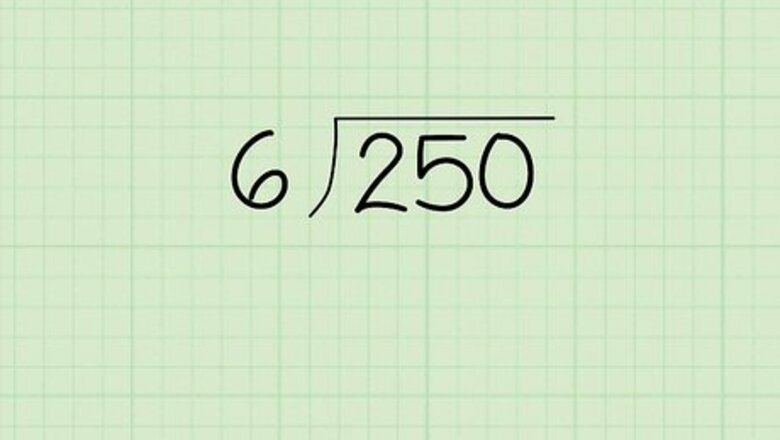
views
X
Research source
Dividing
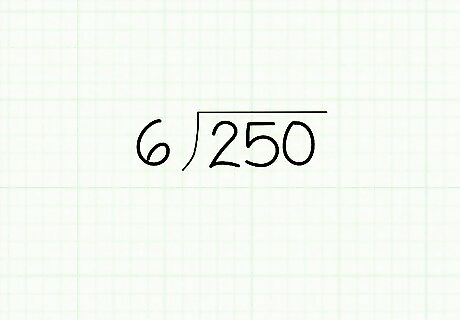
Set up the equation. On a piece of paper, write the dividend (number being divided) on the right, under the division symbol, and the divisor (number doing the division) to the left on the outside. The quotient (answer) will eventually go on top, right above the dividend. Leave yourself plenty of space below the equation to carry out multiple subtraction operations. Here's an example: if there are six mushrooms in a 250-gram pack, how much does each mushroom weigh on average? In this case, we must divide 250 by 6. The 6 goes on the outside, and the 250 on the inside.

Divide the first digit. Work from left to right, and determine how many times the divisor can go into the first digit of the dividend without exceeding it. In our example, you'd want to determine how many times 6 goes into 2. Since six is larger than two, the answer is zero. If you wish, may write a 0 directly above the 2 as a place-holder, and erase it later. Alternatively, you can leave that space blank and move on to the next step.
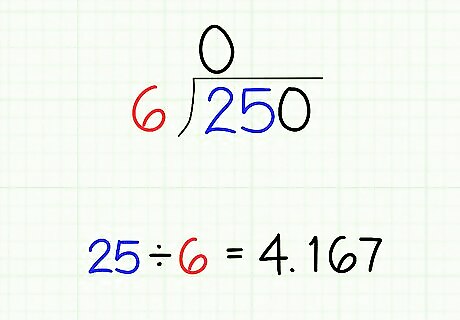
Divide the first two digits. If the divisor is a larger number than the first digit, determine how many times the divisor goes into the first two digits of the dividend without exceeding it. If your answer to the previous step was 0, as in the example, expand the number by one digit. In this case, we'd ask how many times 6 can go into 25. If your divisor has more than two digits, you'll have to expand out even further, to the third or maybe even fourth digit of the dividend in order to get a number that the divisor goes into. Work in terms of whole numbers. If you use a calculator, you'll discover that 6 goes into 25 a total of 4.167 times. In long division, you always round down to the nearest whole number, so in this case, our answer would be 4.
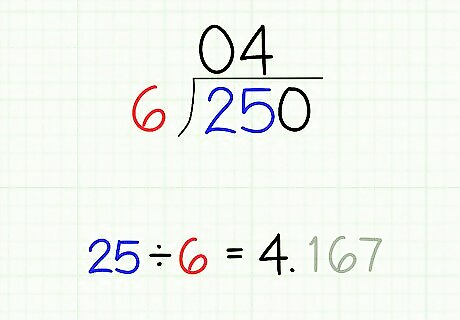
Enter the first digit of the quotient. Put the number of times the divisor goes into the first digit (or digits) of the dividend above the appropriate digit(s). It is important in long division to make sure the columns of numbers remain correctly aligned. Work carefully, otherwise you may make an error that leads you to the wrong answer. In the example, you would place a 4 above the 5, since we're putting 6 into 25.
Multiplying

Multiply the divisor. The divisor should be multiplied by the number you have just written above the dividend. In our example, this is the first digit of the quotient.

Record the product. Put the result of your multiplication in step 1 beneath the dividend. In the example, 6 times 4 is 24. After you've written a 4 in the quotient, write the number 24 beneath the 25, again being careful to keep the numbers aligned.
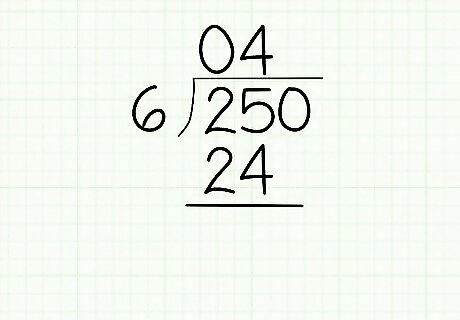
Draw a line. A line should be placed beneath the product of your multiplication, 24 in the example.
Subtracting
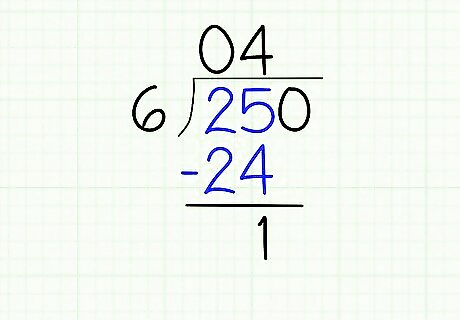
Subtract the product. Subtract the number you just wrote below the dividend from the digits of the dividend directly above it. Write the result beneath the line you just drew. In the example, we'll subtract 24 from 25, getting 1. Do not subtract from the complete dividend, but only those digits you worked with in Parts One and Two. In the example, you should not subtract 24 from 250.
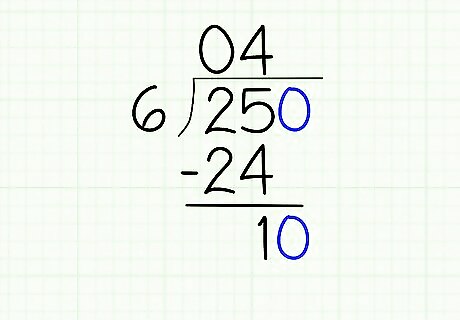
Bring down the next digit. Write the next digit of the dividend after the result of your subtraction operation. In the example, because 6 can't go into 1 without exceeding it, you need to bring down another digit. In this case, you'll grab the 0 from 250 and place it after the 1, making it 10, which 6 can go into.
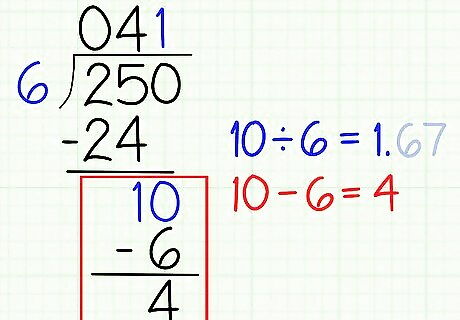
Repeat the whole process. Divide the new number by your divisor, and write the result above the dividend as the next digit of the quotient. In the example, determine how many times 6 can go into 10. Write that number (1) into the quotient above the dividend. Then multiply 6 by 1, and subtract the result from 10. You should end up with 4. If your dividend has more than three digits, keep repeating this process until you've worked through all of them. For example, if we we had started with 2,506 grams (88.4 oz) of mushrooms, we'd pull the 6 down next and place it next to the four.
Remainders and Decimals
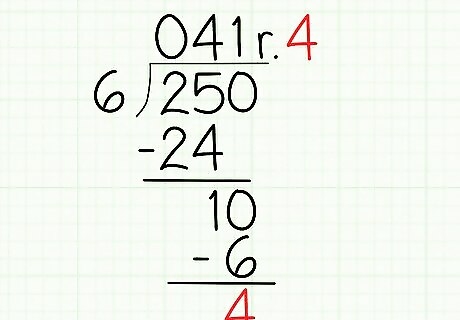
Record the remainder. Depending on what you're using this division for, you may want to finish up with a quotient that's a whole number, with a remainder, i.e. an indication of how much is left over after you've completed your division. In the example, the remainder would be 4, because 6 cannot go into four, and there are no more digits to bring down. Place your remainder after the quotient with a letter "r" before it. In the example, the answer would be expressed as "41 r4." You would stop here if you were trying to calculate something that would not make sense to express in partial units, for example, if you were trying to determine how many cars were needed to move a certain number of people. In a case such as this, it would not be useful think about things in terms of partial cars or partial people. If you plan to calculate a decimal, you can skip this step.
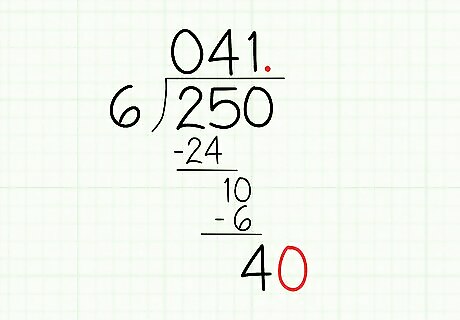
Add a decimal point. If you are planning to calculate a precise answer rather than one with a remainder, you'll now need to move beyond whole numbers. When you've reached a point at which you are left with a number smaller than your divisor, add a decimal point to both the quotient and the dividend. In the example, since 250 is a whole number, every digit after the decimal will be 0, making it 250.000.
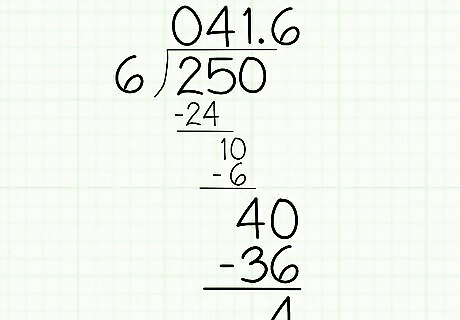
Keep repeating. Now you have more digits that can be brought down (all of them zeroes). Bring down a zero and continue as before, determining how many times the divisor can go into the new number. In the example, determine how many times 6 can go into 40. Add that number (6) to the quotient above the dividend and after the decimal point. Then multiply 6 by 6, and subtract the result from 40. You should end up with 4 again.
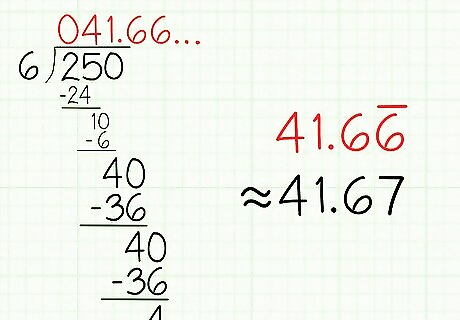
Stop and round. In some cases, you will find that when you start to solve for the decimal, the answer repeats over and over. At this point, it's time to stop and round your answer up (if the repeating number is 5 or greater) or down (if it is 4 or less). In the example, you could keep getting 4 out of 40-36 forever, and add 6's to your quotient indefinitely. Instead of doing this, stop the problem and round the quotient. Because 6 is greater than (or equal to) 5, you would round up to 41.67. Alternatively, you can indicate a repeating decimal by placing a small horizontal line over the repeating digit. In the example, this would make the quotient 41.6, with a line over the 6.
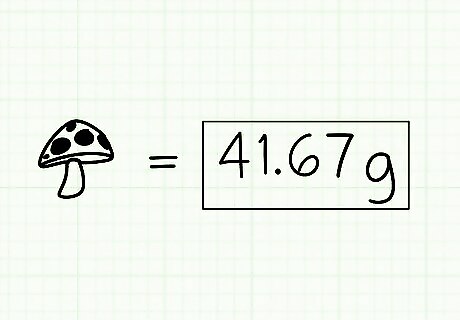
Add the unit back to your answer. If you are working with units like pounds, gallons, or degrees, once you are done with all your calculations, add the unit to the end of your answer. If you added a zero as a place-holder at the beginning, you should erase that now as well. In the example, because you asked how much each mushroom in a 250-gram pack of 6 weighs, you'll need to put your answer into grams. Therefore, your final answer is 41.67 grams.













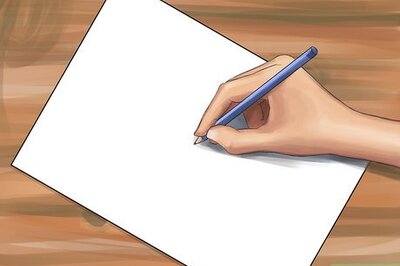

Comments
0 comment